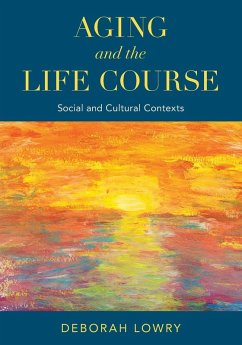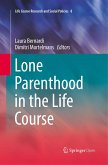- Broschiertes Buch
- Merkliste
- Auf die Merkliste
- Bewerten Bewerten
- Teilen
- Produkt teilen
- Produkterinnerung
- Produkterinnerung
Aging and the Life Course: Social and Cultural Contexts provides an accessible, up-to-date introduction to the study of aging and the life course from a distinctly sociological perspective. It explores the sociocultural dimensions of aging while encouraging critical thinking about the diversity of aging experiences, societal attitudes toward older adults the politics and economics of growing old, and end-of-life resources.
Andere Kunden interessierten sich auch für
![Aging and the Life Course Aging and the Life Course]() Deborah LowryAging and the Life Course161,99 €
Deborah LowryAging and the Life Course161,99 €![Alternsforschung Alternsforschung]() Alternsforschung58,00 €
Alternsforschung58,00 €![Alternsforschung Alternsforschung]() Alternsforschung99,00 €
Alternsforschung99,00 €![The SAGE Handbook of Social Gerontology The SAGE Handbook of Social Gerontology]() The SAGE Handbook of Social Gerontology161,99 €
The SAGE Handbook of Social Gerontology161,99 €![Music in the Course of Life Music in the Course of Life]() Joseph A. KotarbaMusic in the Course of Life149,99 €
Joseph A. KotarbaMusic in the Course of Life149,99 €![Lone Parenthood in the Life Course Lone Parenthood in the Life Course]() Lone Parenthood in the Life Course38,99 €
Lone Parenthood in the Life Course38,99 €![Negotiating the Life Course Negotiating the Life Course]() Negotiating the Life Course76,99 €
Negotiating the Life Course76,99 €-
-
-
Aging and the Life Course: Social and Cultural Contexts provides an accessible, up-to-date introduction to the study of aging and the life course from a distinctly sociological perspective. It explores the sociocultural dimensions of aging while encouraging critical thinking about the diversity of aging experiences, societal attitudes toward older adults the politics and economics of growing old, and end-of-life resources.
Produktdetails
- Produktdetails
- Verlag: Rowman & Littlefield Publishers
- Seitenzahl: 414
- Erscheinungstermin: 15. Januar 2022
- Englisch
- Abmessung: 254mm x 178mm x 22mm
- Gewicht: 775g
- ISBN-13: 9781538143254
- ISBN-10: 1538143259
- Artikelnr.: 60020923
- Herstellerkennzeichnung
- Libri GmbH
- Europaallee 1
- 36244 Bad Hersfeld
- gpsr@libri.de
- Verlag: Rowman & Littlefield Publishers
- Seitenzahl: 414
- Erscheinungstermin: 15. Januar 2022
- Englisch
- Abmessung: 254mm x 178mm x 22mm
- Gewicht: 775g
- ISBN-13: 9781538143254
- ISBN-10: 1538143259
- Artikelnr.: 60020923
- Herstellerkennzeichnung
- Libri GmbH
- Europaallee 1
- 36244 Bad Hersfeld
- gpsr@libri.de
Deborah Lowry is associate professor of sociology in the Department of Behavioral and Social Sciences at the University of Montevallo, where she teaches a variety of courses including aging and the life course, social problems, introductory sociology, and contemporary Chinese society. Prior to a National Institutes of Health (NIH) postdoctoral research fellowship at the University of Michigan's Population Studies Center, she earned a PhD from Michigan State University with research that investigated lived experiences of aging in a rural Chinese context.
*Every chapter concludes with key terms and concepts, questions for
reflection and discussion, and chapter references
Preface
PART I: FOUNDATIONS
Chapter 1: Global Contexts of Aging: A Sociological Perspective
The Demography of Aging and Why It Matters
Global Diversity in Population Aging
Government Responses to Population Aging
Constructing "the Aging Population Problem"
Who Benefits from Representations of Population Aging?
This Chapter's Practical Applications and Everyday Relevance
Summary and Conclusion
Chapter 2: Sociological Imagination and the Life Course Perspective
The Life Course Perspective and Its Vocabulary
Central Principles of the Life Course Perspective
Key Concepts in Life Course Studies
This Chapter's Practical Applications and Everyday Relevance
Summary and Conclusion
Chapter 3: The Social Construction of Age, Aging, and Life Stages
Age Norms
Age as a Social Identity
Social Constructs and Their Consequences for Aging
Social Construction of Life Stages
Constructing Age and Aging
This Chapter's Practical Applications and Everyday Relevance
Summary and Conclusion
PART II: EXPERIENCES AND CONDITIONS OF LATER LIFE
Chapter 4: Sociocultural Contexts of Ageism
Defining Ageism
Ageism: Familiar but Unique
Ageism, Popular Culture, and Representations of Later Life
Negative Views of Older Adults and Later Life: Theoretical Explanations
Ageism: Real Consequences
Practical Steps: Resisting "the Last Acceptable Ism"
This Chapter's Practical Applications and Everyday Relevance
Summary and Conclusion
Chapter 5: Aging, Health, and Wellbeing: Central Concepts and
Sociological Approaches
The Social Causes of Health and Illness Model
Sociological Explanations for Later-Life Health and Wellbeing: The Theories
Later-Life Health: Common Measurements and Historical Trends
Later-Life Health in the Contemporary United States
Later-Life Healthcare in the United States: Some Macro-Level Social
Contexts
This Chapter's Practical Applications and Everyday Relevance
Summary and Conclusion
Chapter 6: Later-Life Inequalities: At the Intersections
Patterns and Their Implications
Later-Life Resources: Differences and Inequalities
Intersecting Patterns in Later-Life Health and Wellbeing
Disability and Aging
Aging into Disability and Aging with Disability
This Chapter's Practical Applications and Everyday Relevance
Summary and Conclusion
PART III: ACTIVITIES OF LATER LIFE
Chapter 7: Aging, Work, and the Sociology of Retirement
Work and the Life Course
Retirement as a Social Institution
Retirement as a Life Course Transition
Sociocultural Meanings of Retirement
Aging and Employment in the United States
Contemporary Retirement in the United States
This Chapter's Practical Applications and Everyday Relevance
Summary and Conclusion
Chapter 8: Social Convoys, Marriage, Divorce, and Intimacy in Later Life
Social Networks and Social Convoys in Later Life
Aging and Friendship
Later-Life Partnerships
"Gray Divorce" and Widowhood
Repartnering in Later Life
This Chapter's Practical Applications and Everyday Relevance
Summary and Conclusion
Chapter 9: Aging, Families, and Intergenerational Exchanges
Family as a Social Institution
Intergenerational Ties and Exchanges: Theories and Concepts
Types of Intergenerational Support Exchanges
Grandparenting Roles and Relationships
Caregiving for (and by) Older Adults
Elder Abuse
This Chapter's Practical Applications and Everyday Relevance
Summary and Conclusion
PART IV: AGING AND SOCIAL CHANGE
Chapter 10: Generational Identity, Conflict, and Societal Change
Social Change and "The Youth"
Generationalism and Social Change
Generational Differences: What Research Finds
Omens of a "Generation War"?
Challenging the Conflict Narrative
This Chapter's Practical Applications and Everyday Relevance
Summary and Conclusion
Chapter 11: Aging, Place, and Built Environments
A Brief Sociology of Place, Aging, and Built Environment
Aging, Wellbeing, and Immediate Built Environments
A Sociology of Aging in Place
Creating Age-Friendly Public Spaces
This Chapter's Practical Applications and Everyday Relevance
Summary and Conclusion
Chapter 12: End of Life and the Future of Aging
Death: Social Attitudes and Expectations
Contemporary Patterns of Later-Life Mortality
Social Change and End-of-Life Experiences
Aging in a Post-Pandemic World
Aging in the Coming Century
This Chapter's Practical Applications and Everyday Relevance
Summary and Conclusion
Glossary
Index
reflection and discussion, and chapter references
Preface
PART I: FOUNDATIONS
Chapter 1: Global Contexts of Aging: A Sociological Perspective
The Demography of Aging and Why It Matters
Global Diversity in Population Aging
Government Responses to Population Aging
Constructing "the Aging Population Problem"
Who Benefits from Representations of Population Aging?
This Chapter's Practical Applications and Everyday Relevance
Summary and Conclusion
Chapter 2: Sociological Imagination and the Life Course Perspective
The Life Course Perspective and Its Vocabulary
Central Principles of the Life Course Perspective
Key Concepts in Life Course Studies
This Chapter's Practical Applications and Everyday Relevance
Summary and Conclusion
Chapter 3: The Social Construction of Age, Aging, and Life Stages
Age Norms
Age as a Social Identity
Social Constructs and Their Consequences for Aging
Social Construction of Life Stages
Constructing Age and Aging
This Chapter's Practical Applications and Everyday Relevance
Summary and Conclusion
PART II: EXPERIENCES AND CONDITIONS OF LATER LIFE
Chapter 4: Sociocultural Contexts of Ageism
Defining Ageism
Ageism: Familiar but Unique
Ageism, Popular Culture, and Representations of Later Life
Negative Views of Older Adults and Later Life: Theoretical Explanations
Ageism: Real Consequences
Practical Steps: Resisting "the Last Acceptable Ism"
This Chapter's Practical Applications and Everyday Relevance
Summary and Conclusion
Chapter 5: Aging, Health, and Wellbeing: Central Concepts and
Sociological Approaches
The Social Causes of Health and Illness Model
Sociological Explanations for Later-Life Health and Wellbeing: The Theories
Later-Life Health: Common Measurements and Historical Trends
Later-Life Health in the Contemporary United States
Later-Life Healthcare in the United States: Some Macro-Level Social
Contexts
This Chapter's Practical Applications and Everyday Relevance
Summary and Conclusion
Chapter 6: Later-Life Inequalities: At the Intersections
Patterns and Their Implications
Later-Life Resources: Differences and Inequalities
Intersecting Patterns in Later-Life Health and Wellbeing
Disability and Aging
Aging into Disability and Aging with Disability
This Chapter's Practical Applications and Everyday Relevance
Summary and Conclusion
PART III: ACTIVITIES OF LATER LIFE
Chapter 7: Aging, Work, and the Sociology of Retirement
Work and the Life Course
Retirement as a Social Institution
Retirement as a Life Course Transition
Sociocultural Meanings of Retirement
Aging and Employment in the United States
Contemporary Retirement in the United States
This Chapter's Practical Applications and Everyday Relevance
Summary and Conclusion
Chapter 8: Social Convoys, Marriage, Divorce, and Intimacy in Later Life
Social Networks and Social Convoys in Later Life
Aging and Friendship
Later-Life Partnerships
"Gray Divorce" and Widowhood
Repartnering in Later Life
This Chapter's Practical Applications and Everyday Relevance
Summary and Conclusion
Chapter 9: Aging, Families, and Intergenerational Exchanges
Family as a Social Institution
Intergenerational Ties and Exchanges: Theories and Concepts
Types of Intergenerational Support Exchanges
Grandparenting Roles and Relationships
Caregiving for (and by) Older Adults
Elder Abuse
This Chapter's Practical Applications and Everyday Relevance
Summary and Conclusion
PART IV: AGING AND SOCIAL CHANGE
Chapter 10: Generational Identity, Conflict, and Societal Change
Social Change and "The Youth"
Generationalism and Social Change
Generational Differences: What Research Finds
Omens of a "Generation War"?
Challenging the Conflict Narrative
This Chapter's Practical Applications and Everyday Relevance
Summary and Conclusion
Chapter 11: Aging, Place, and Built Environments
A Brief Sociology of Place, Aging, and Built Environment
Aging, Wellbeing, and Immediate Built Environments
A Sociology of Aging in Place
Creating Age-Friendly Public Spaces
This Chapter's Practical Applications and Everyday Relevance
Summary and Conclusion
Chapter 12: End of Life and the Future of Aging
Death: Social Attitudes and Expectations
Contemporary Patterns of Later-Life Mortality
Social Change and End-of-Life Experiences
Aging in a Post-Pandemic World
Aging in the Coming Century
This Chapter's Practical Applications and Everyday Relevance
Summary and Conclusion
Glossary
Index
*Every chapter concludes with key terms and concepts, questions for
reflection and discussion, and chapter references
Preface
PART I: FOUNDATIONS
Chapter 1: Global Contexts of Aging: A Sociological Perspective
The Demography of Aging and Why It Matters
Global Diversity in Population Aging
Government Responses to Population Aging
Constructing "the Aging Population Problem"
Who Benefits from Representations of Population Aging?
This Chapter's Practical Applications and Everyday Relevance
Summary and Conclusion
Chapter 2: Sociological Imagination and the Life Course Perspective
The Life Course Perspective and Its Vocabulary
Central Principles of the Life Course Perspective
Key Concepts in Life Course Studies
This Chapter's Practical Applications and Everyday Relevance
Summary and Conclusion
Chapter 3: The Social Construction of Age, Aging, and Life Stages
Age Norms
Age as a Social Identity
Social Constructs and Their Consequences for Aging
Social Construction of Life Stages
Constructing Age and Aging
This Chapter's Practical Applications and Everyday Relevance
Summary and Conclusion
PART II: EXPERIENCES AND CONDITIONS OF LATER LIFE
Chapter 4: Sociocultural Contexts of Ageism
Defining Ageism
Ageism: Familiar but Unique
Ageism, Popular Culture, and Representations of Later Life
Negative Views of Older Adults and Later Life: Theoretical Explanations
Ageism: Real Consequences
Practical Steps: Resisting "the Last Acceptable Ism"
This Chapter's Practical Applications and Everyday Relevance
Summary and Conclusion
Chapter 5: Aging, Health, and Wellbeing: Central Concepts and
Sociological Approaches
The Social Causes of Health and Illness Model
Sociological Explanations for Later-Life Health and Wellbeing: The Theories
Later-Life Health: Common Measurements and Historical Trends
Later-Life Health in the Contemporary United States
Later-Life Healthcare in the United States: Some Macro-Level Social
Contexts
This Chapter's Practical Applications and Everyday Relevance
Summary and Conclusion
Chapter 6: Later-Life Inequalities: At the Intersections
Patterns and Their Implications
Later-Life Resources: Differences and Inequalities
Intersecting Patterns in Later-Life Health and Wellbeing
Disability and Aging
Aging into Disability and Aging with Disability
This Chapter's Practical Applications and Everyday Relevance
Summary and Conclusion
PART III: ACTIVITIES OF LATER LIFE
Chapter 7: Aging, Work, and the Sociology of Retirement
Work and the Life Course
Retirement as a Social Institution
Retirement as a Life Course Transition
Sociocultural Meanings of Retirement
Aging and Employment in the United States
Contemporary Retirement in the United States
This Chapter's Practical Applications and Everyday Relevance
Summary and Conclusion
Chapter 8: Social Convoys, Marriage, Divorce, and Intimacy in Later Life
Social Networks and Social Convoys in Later Life
Aging and Friendship
Later-Life Partnerships
"Gray Divorce" and Widowhood
Repartnering in Later Life
This Chapter's Practical Applications and Everyday Relevance
Summary and Conclusion
Chapter 9: Aging, Families, and Intergenerational Exchanges
Family as a Social Institution
Intergenerational Ties and Exchanges: Theories and Concepts
Types of Intergenerational Support Exchanges
Grandparenting Roles and Relationships
Caregiving for (and by) Older Adults
Elder Abuse
This Chapter's Practical Applications and Everyday Relevance
Summary and Conclusion
PART IV: AGING AND SOCIAL CHANGE
Chapter 10: Generational Identity, Conflict, and Societal Change
Social Change and "The Youth"
Generationalism and Social Change
Generational Differences: What Research Finds
Omens of a "Generation War"?
Challenging the Conflict Narrative
This Chapter's Practical Applications and Everyday Relevance
Summary and Conclusion
Chapter 11: Aging, Place, and Built Environments
A Brief Sociology of Place, Aging, and Built Environment
Aging, Wellbeing, and Immediate Built Environments
A Sociology of Aging in Place
Creating Age-Friendly Public Spaces
This Chapter's Practical Applications and Everyday Relevance
Summary and Conclusion
Chapter 12: End of Life and the Future of Aging
Death: Social Attitudes and Expectations
Contemporary Patterns of Later-Life Mortality
Social Change and End-of-Life Experiences
Aging in a Post-Pandemic World
Aging in the Coming Century
This Chapter's Practical Applications and Everyday Relevance
Summary and Conclusion
Glossary
Index
reflection and discussion, and chapter references
Preface
PART I: FOUNDATIONS
Chapter 1: Global Contexts of Aging: A Sociological Perspective
The Demography of Aging and Why It Matters
Global Diversity in Population Aging
Government Responses to Population Aging
Constructing "the Aging Population Problem"
Who Benefits from Representations of Population Aging?
This Chapter's Practical Applications and Everyday Relevance
Summary and Conclusion
Chapter 2: Sociological Imagination and the Life Course Perspective
The Life Course Perspective and Its Vocabulary
Central Principles of the Life Course Perspective
Key Concepts in Life Course Studies
This Chapter's Practical Applications and Everyday Relevance
Summary and Conclusion
Chapter 3: The Social Construction of Age, Aging, and Life Stages
Age Norms
Age as a Social Identity
Social Constructs and Their Consequences for Aging
Social Construction of Life Stages
Constructing Age and Aging
This Chapter's Practical Applications and Everyday Relevance
Summary and Conclusion
PART II: EXPERIENCES AND CONDITIONS OF LATER LIFE
Chapter 4: Sociocultural Contexts of Ageism
Defining Ageism
Ageism: Familiar but Unique
Ageism, Popular Culture, and Representations of Later Life
Negative Views of Older Adults and Later Life: Theoretical Explanations
Ageism: Real Consequences
Practical Steps: Resisting "the Last Acceptable Ism"
This Chapter's Practical Applications and Everyday Relevance
Summary and Conclusion
Chapter 5: Aging, Health, and Wellbeing: Central Concepts and
Sociological Approaches
The Social Causes of Health and Illness Model
Sociological Explanations for Later-Life Health and Wellbeing: The Theories
Later-Life Health: Common Measurements and Historical Trends
Later-Life Health in the Contemporary United States
Later-Life Healthcare in the United States: Some Macro-Level Social
Contexts
This Chapter's Practical Applications and Everyday Relevance
Summary and Conclusion
Chapter 6: Later-Life Inequalities: At the Intersections
Patterns and Their Implications
Later-Life Resources: Differences and Inequalities
Intersecting Patterns in Later-Life Health and Wellbeing
Disability and Aging
Aging into Disability and Aging with Disability
This Chapter's Practical Applications and Everyday Relevance
Summary and Conclusion
PART III: ACTIVITIES OF LATER LIFE
Chapter 7: Aging, Work, and the Sociology of Retirement
Work and the Life Course
Retirement as a Social Institution
Retirement as a Life Course Transition
Sociocultural Meanings of Retirement
Aging and Employment in the United States
Contemporary Retirement in the United States
This Chapter's Practical Applications and Everyday Relevance
Summary and Conclusion
Chapter 8: Social Convoys, Marriage, Divorce, and Intimacy in Later Life
Social Networks and Social Convoys in Later Life
Aging and Friendship
Later-Life Partnerships
"Gray Divorce" and Widowhood
Repartnering in Later Life
This Chapter's Practical Applications and Everyday Relevance
Summary and Conclusion
Chapter 9: Aging, Families, and Intergenerational Exchanges
Family as a Social Institution
Intergenerational Ties and Exchanges: Theories and Concepts
Types of Intergenerational Support Exchanges
Grandparenting Roles and Relationships
Caregiving for (and by) Older Adults
Elder Abuse
This Chapter's Practical Applications and Everyday Relevance
Summary and Conclusion
PART IV: AGING AND SOCIAL CHANGE
Chapter 10: Generational Identity, Conflict, and Societal Change
Social Change and "The Youth"
Generationalism and Social Change
Generational Differences: What Research Finds
Omens of a "Generation War"?
Challenging the Conflict Narrative
This Chapter's Practical Applications and Everyday Relevance
Summary and Conclusion
Chapter 11: Aging, Place, and Built Environments
A Brief Sociology of Place, Aging, and Built Environment
Aging, Wellbeing, and Immediate Built Environments
A Sociology of Aging in Place
Creating Age-Friendly Public Spaces
This Chapter's Practical Applications and Everyday Relevance
Summary and Conclusion
Chapter 12: End of Life and the Future of Aging
Death: Social Attitudes and Expectations
Contemporary Patterns of Later-Life Mortality
Social Change and End-of-Life Experiences
Aging in a Post-Pandemic World
Aging in the Coming Century
This Chapter's Practical Applications and Everyday Relevance
Summary and Conclusion
Glossary
Index









